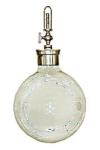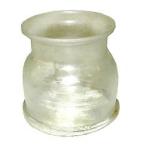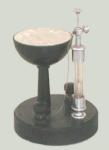Description
It is right for pressures until 2 atmospheres. The model is very simple and solid.
The two branches of the glass tube are joined in the bottom with a connection of iron
provided with a lateral key for the unloading. It can easily move the mercury to the first
notch of the scale of the volumes. The branch that must hold the mass of air is provided
with a glass key, so that it is easy to move the mercury to the same level in the two
branches and to shut the air at the external pressure.
The scale of the volumes is cm 24 and shows clearly the notches that correspond to the
volumes 1, 2/3, ½. The scale of the pressure is sliding and it is possible to note from
afar the notches corresponding to the pressures 1, 3/32, 2. The shift of the scale,
uncommon in apparatus of this type, avoids the disadvantage of having to substrate the
height of the mercury in the shorter branch from the height of the mercury in the longer
one at the moment of each experiment. It is recommended to oil the glass key for a perfect
hermetic seal.
|


 Menu
Menu















